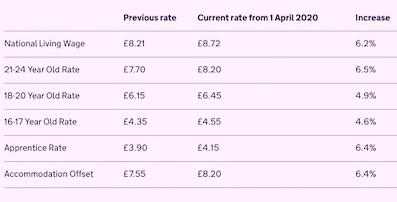 Cleanzine: your weekly cleaning and hygiene industry newsletter 10th July 2025 Issue no. 1170
Cleanzine: your weekly cleaning and hygiene industry newsletter 10th July 2025 Issue no. 1170
Your industry news - first
The original and best - for over 20 years!
We strongly recommend viewing Cleanzine full size in your web browser. Click our masthead above to visit our website version.
National Living Wage increase raises income of low-paid workers
 The National Living Wage increased yesterday (1st April) to £8.72, giving a pay rise to thousands of workers at the frontline of the UK's response to Covid-19. This rise follows recommendations made to the Government by the Low Pay Commission in the Autumn.
The National Living Wage increased yesterday (1st April) to £8.72, giving a pay rise to thousands of workers at the frontline of the UK's response to Covid-19. This rise follows recommendations made to the Government by the Low Pay Commission in the Autumn.
It means the rate reaches the target of 60% of median earnings, originally set by the Government in 2015.
In the 11th March Budget, the Government confirmed its ambition for the NLW to continue increasing towards a new target of two-thirds of median earnings by 2024. It asked the LPC to advise on whether the economic evidence warranted these increases. The LPC will make its recommendations to Government on the 2021 National Minimum Wage rates in October.
"Many of the nation's key workers - in, for example, the care sector, agriculture, transport and retail - are low-paid," says Bryan Sanderson, chair of the Low Pay Commission. "They are continuing to work in very difficult conditions and will benefit from this week's increase. At the same time, the Government has introduced a comprehensive package of support for employers to lessen the impacts of these extraordinary circumstances.
"Under our new remit, the Government asks us to monitor the labour market and the impacts of the National Living Wage closely, advise on any emerging risks and - if the economic evidence warrants it - recommend that the Government reviews its target or timeframe. This is what the Government refers to as the 'emergency brake'.
"The ongoing Covid-19 pandemic clearly represents a very challenging set of circumstances for workers and employers alike, and will require us to review whether the emergency brake is required when we next provide our advice to the Government. This advice will be crucially dependent as always on the economic data we receive."
The LPC has published a short report looking at the NLW's path to the 60% target and outlining how we will approach the new two-thirds target. This report does not set out a pathway to the new target, given the uncertainty over the current and future state of the labour market.
The other rates of the National Minimum Wage will also increase alongside the NLW.
The National Living Wage is different from the UK Living Wage and the London Living Wage calculated by the Living Wage Foundation. Differences include that: the UK Living Wage and the London Living Wage are voluntary pay benchmarks that employers can sign up to if they wish, not legally binding requirements; the hourly rate of the UK Living Wage and London Living Wage is based on an attempt to measure need, whereas the National Living Wage is based on a target relationship between its level and average pay; the UK Living Wage and London Living Wage apply to workers aged 18 and over, the National Living Wage to workers aged 25 and over. The Low Pay Commission has no role in the UK Living Wage or the London Living Wage.
2nd April 2020







